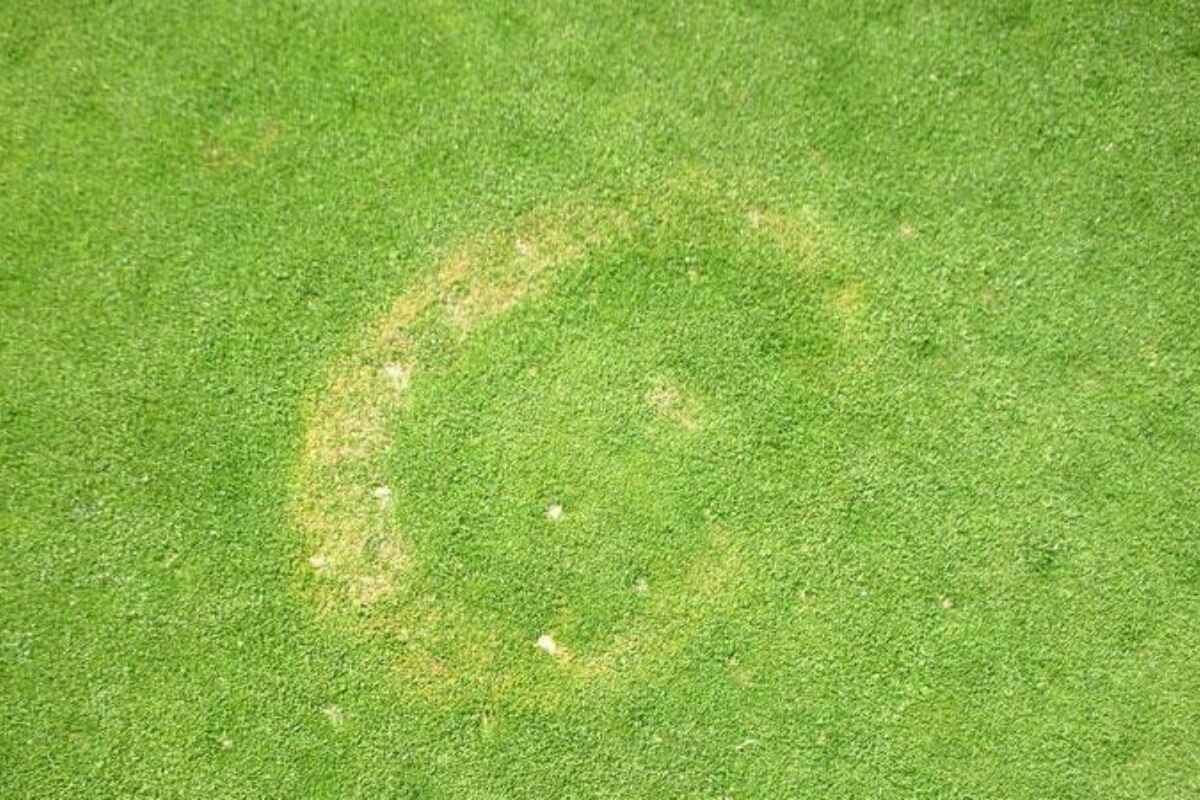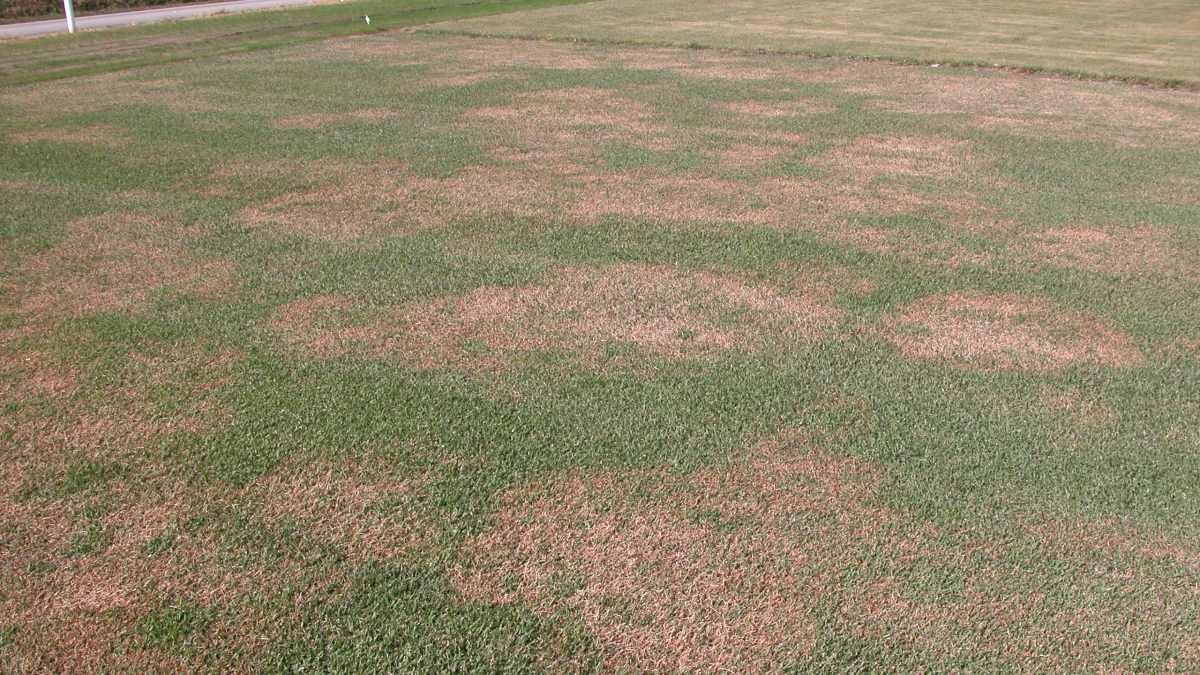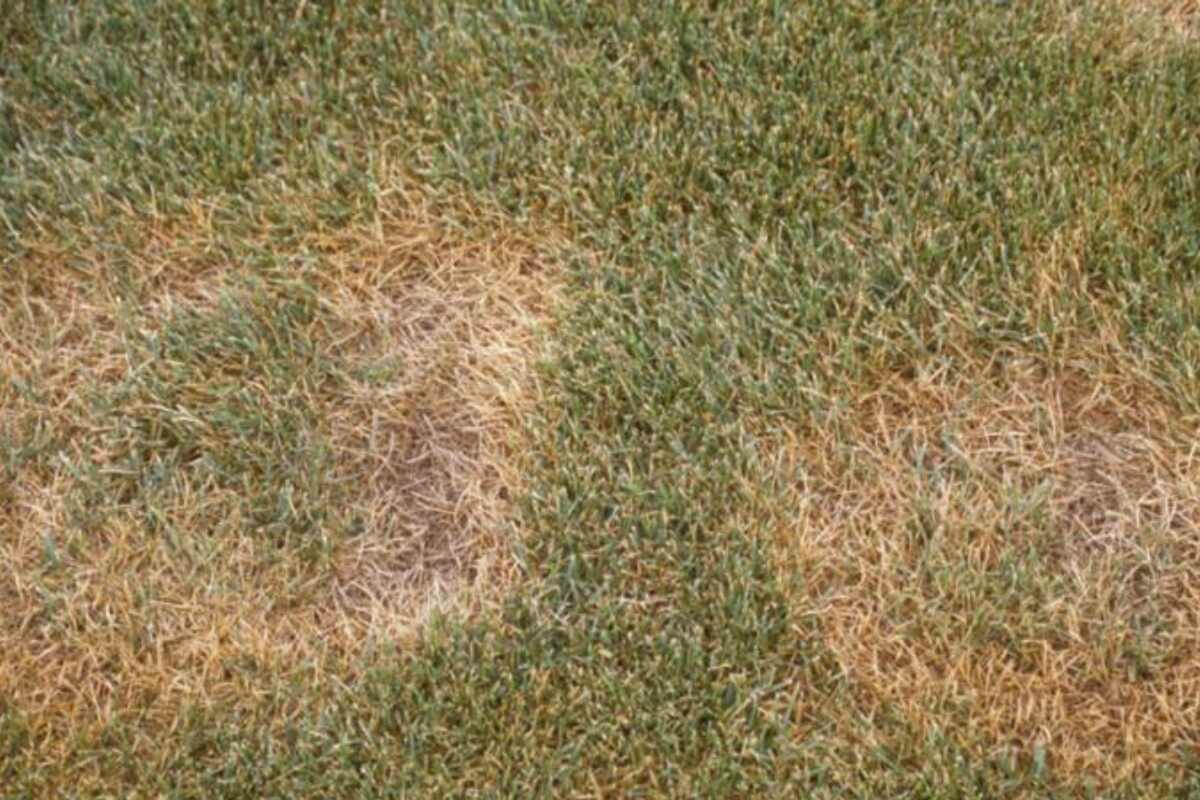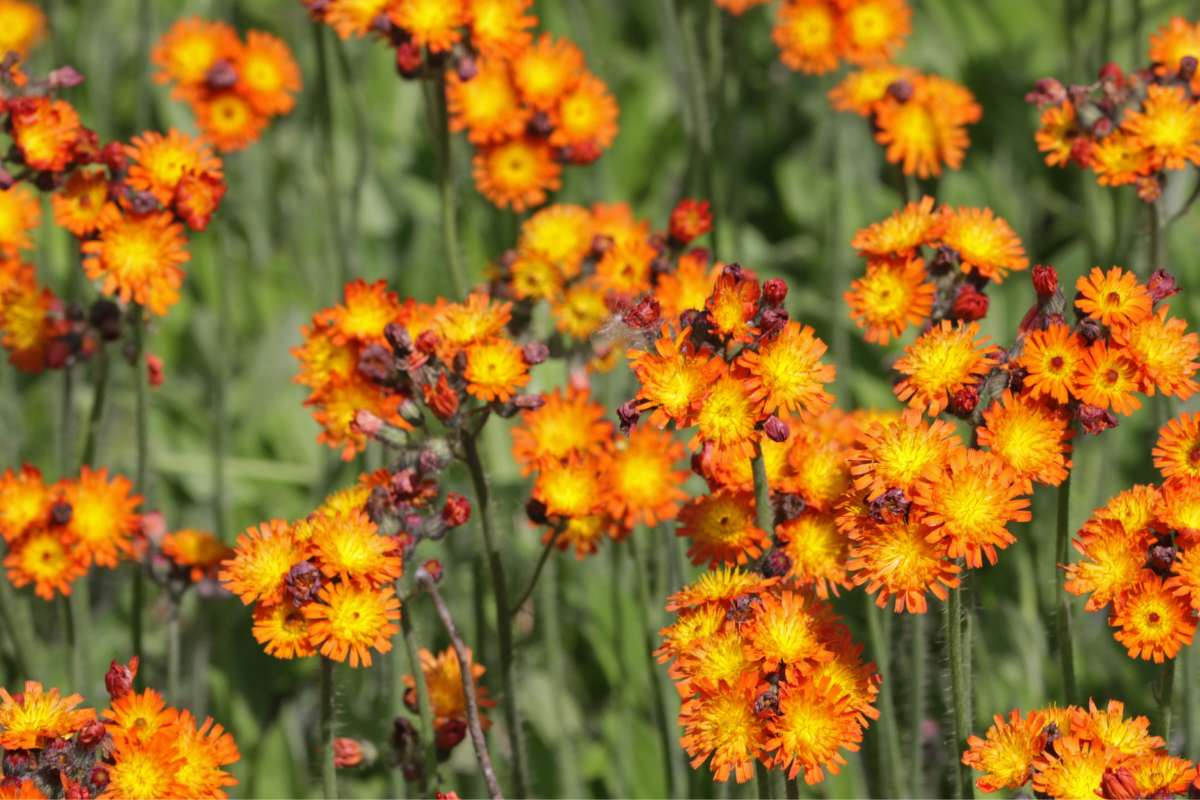
Just like any living organism, lawns are susceptible to diseases that can quickly turn a once-healthy green expanse into a patchy, unsightly mess. Recognizing and addressing these diseases promptly is essential to keep your lawn looking its best. In this article, we discuss the most common lawn diseases in the United States and how to identify them.
Once you figure out which disease is causing your lawn’s problems, you’ll be able to treat it and prevent it from coming back.
- How to Identify Common Lawn Diseases
- 1. Dollar Spot
- 2. Red Thread
- 3. Brown Patch (Rhizoctonia blight)
- 4. Large Patch (Rhizoctonia large patch, Zoysia patch)
- 5. Yellow Patch (Cold-season brown patch)
- 6. Pythium Blight (Grease Spot)
- 7. Fairy Ring
- 8. Gray Leaf Spot
- 9. Fusarium Blight
- 10. Powdery Mildew
- 11. Spring Dead Spot
- 12. Summer Patch (Poa Patch)
- 13. Leaf Rust
- 14. Leaf Spot
- 15. Melting Out
- 16. Take-All Root Rot (TARR)
- 17. Leaf Blight
- 18. Gray Snow Mold (Typhula blight)
- 19. Pink Snow Mold (Microdochium patch)
- 20. Anthracnose Foliar Blight and Root Rot
- How to Prevent Lawn Diseases
- FAQ
How to Identify Common Lawn Diseases
For fungal turf diseases to trigger and develop in your lawn, three elements must be present:
- A virulent pathogen abundant enough to trigger an infection
- A turfgrass type susceptible to the fungal pathogen
- Environmental conditions favoring the disease (extreme heat or cold, high moisture, poor air circulation, etc.)
When these three conditions are met, the disease appears with subtle signs or entire patches wilted overnight. Some typical symptoms that give away fungal infections are:
- Leaf spots, typically straw-like or tan but also of different colors with or without a defined border.
- Bleached or yellow leaves withered from the tip.
- Rotted crowns and roots.
- Whitish, cottony growth or small, rigid pea-like structures (sclerotia) on grass and soil.
- Small to large patches of discolored or dying lawn.
Remember that some fungal disease symptoms are similar to damage from other causes, such as:
- Improper watering, fertilizing, or mowing habits.
- Grass damage from herbicides, pesticides, pet urine, and other chemicals.
- Poor drainage due to soil compaction and thick thatch.
- Pest damage.
- Excessively high or low temperatures.
- Competing vegetation.
To offer your lawn the best treatment, you must know if it’s a fungal disease and which one. If unsure of what you see on your grass, take a test sample and ask for a professional opinion from your local Cooperative Extension agent, a lawn care professional, or a plant disease diagnostic laboratory.
Here’s how to take a grass sample correctly:
- Collect entire grass plants with leaves, stems, stolons, and roots. Frequently, signs are visible on the foliar level (the grass blades), but the infection is on the root or crown zone.
- Take samples from several lawn areas, trying to cover more stages of the disease.
- Include samples from the edge of the infected areas, with plants just beginning to show symptoms. It’s where the pathogen is best represented.
Put the samples in plastic bags with moist paper towels to prevent drying. Keep them in the refrigerator if necessary (not in the freezer). Label the samples and write down all helpful information, such as:
- Type of grass in your lawn.
- The damage you noticed on your turf.
- Mowing and watering habits.
- Any recent treatments with fertilizers, pesticides, or herbicides.
All this being said, here are the most common fungal lawn diseases to watch out for and how to identify each one.
1. Dollar Spot
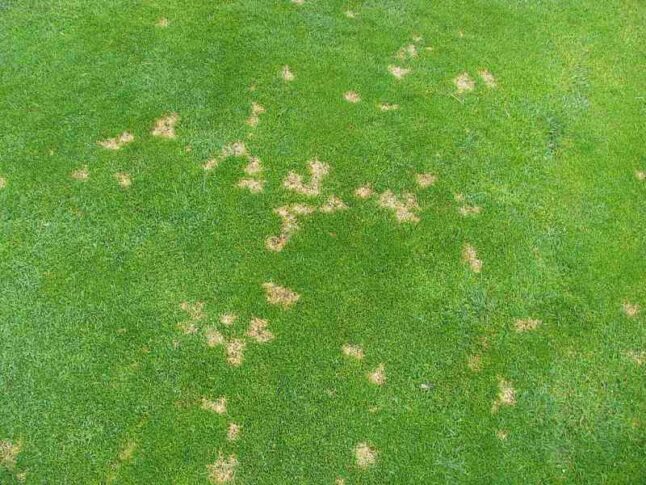
Caused by the Clarireedia jacksonii (formerly Sclerotinia homoeocarpa) fungi, the dollar spot disease mainly attacks the grass blades and rarely kills the turf. In severe cases, though, it can start damaging the roots, leading to grass death. Here’s how to identify a dollar spot infection in time.
Favorable weather: Spring through fall. Periods with warm days (70 to 85°F) and nights (>60°F) and high humidity (rainy season, heavy dew, overwatering).
Leaf damage: Tan lesions with reddish-brown margins.
Root damage: Rare.
How to identify dollar spot in your lawn:
- Small gold dollar-size (hence the name) yellow or straw-colored to light brown circular spots extending up to 5 inches in diameter.
- Multiple spots might merge and form larger, irregularly shaped patches.
Other symptoms of dollar spot disease: White cobweb-like threads are visible early in the morning on soil and turf.
Susceptible turfgrasses: Fine fescue, perennial ryegrass, bentgrass, centipedegrass, Kentucky bluegrass, tall fescue, Bermudagrass, and Zoysiagrass.
Lawn conditions favoring dollar spot disease:
- Soil is low in nitrogen.
- Thick thatch layer.
- Soil compaction.
- Poor drainage.
How to get rid of dollar spot:
- Apply a compost top dressing over the lawn.
- Correct nitrogen deficiencies.
- Remove the thatch layer.
- Water early in the morning, deeply and less often, to promote a robust root system.
- Consider applying fungicides only in severe cases.
Learn more about how to identify, treat, and prevent dollar spot in our article: What is Dollar Spot?
2. Red Thread
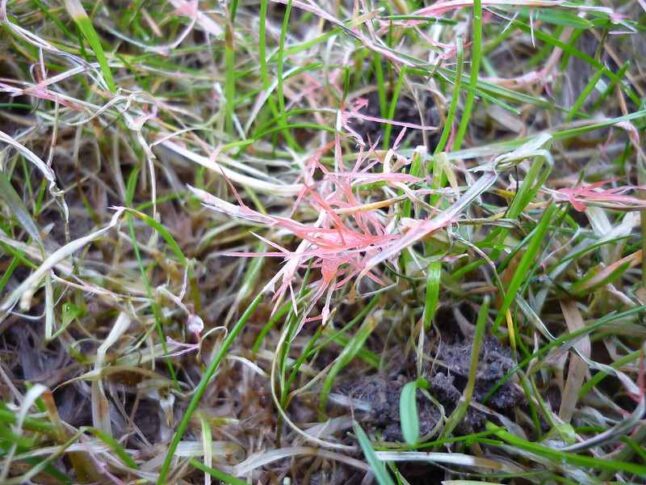
Laetisaria fuciformis is the fungi behind the red thread disease that makes your lawn look like children playing with pink and red silly string. Though it makes a mess of your neat turf, it rarely kills the grass, and plants recover quickly with proper intervention. Here are some clues to help you identify it in time.
Favorable weather: Spring. Mild temperatures of 60° to 75°F and prolonged leaf moisture from long-lasting rain or heavy dew.
Leaf damage: Grass blades wither from the top, taking on a whitish, bleached-like look. Pinkish-red threads (known as sclerotia) emerge from the tips of infected blades, making the grass look like it has split hair ends.
Root damage: Rare.
How to identify red thread in your lawn: From a distance, it looks like reddish or pinkish patches up to 2 feet wide. At a closer look, you see a mix of healthy and diseased tan to bleached-looking grass.
Other symptoms of the red thread disease: On humid days, a pink gelatinous fungal crust sets on the leaves, binding them together. It’s the fungal mycelium and often ends up on shoes, mowers, and lawn care tools.
Susceptible turfgrasses: Fine fescues and perennial ryegrass are most often infected. Bentgrass and bluegrass are also vulnerable.
Lawn conditions favoring the red thread disease:
- Nitrogen deficiency.
- Compacted soil.
- Thatch buildup.
- Dead leaves left on the lawn for too long.
- Prolonged leaf wetness from evening watering and moist weather.
- Shaded areas.
How to get rid of red thread disease:
- Apply a small amount of quick-release nitrogen.
- Improve exposure to sunlight by trimming trees and shrubs.
- Keep soil pH between 6.5 and 7.
- Aerate and dethatch the lawn to increase drainage and air circulation.
Read our guide on red thread and pink patch (a similar disease) to learn more about symptoms, prevention, and treatment.
3. Brown Patch (Rhizoctonia blight)
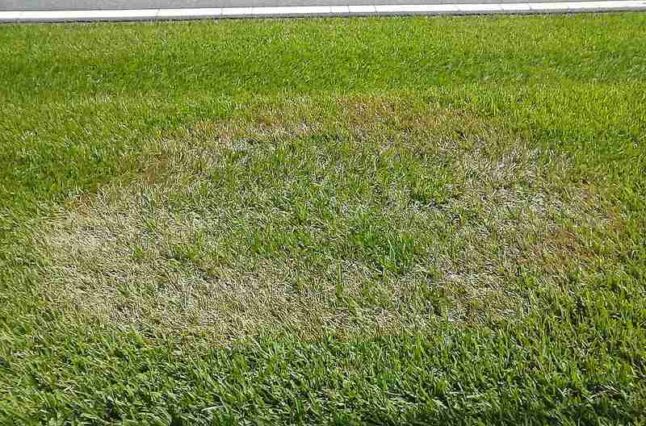
The fungus Rhizoctonia stoloni, which causes the brown patch disease, threatens cool-season grasses in warm and wet weather.
It survives in thatch and turf debris and comes back year after year. Use a prevention herbicide if you had a bad brown patch infection last season or have new seedlings on your lawn.
Favorable weather: Summer. Hot days with temperatures between 75 to 95°F mixed with high humidity.
Leaf damage: Circular and oblong lesions with a straw-colored center and a brown, purple edge. In time, lesions cover the entire surface of the grass blades.
Root damage: No effects on crowns and roots.
How to identify brown patch disease in your lawn: Starts as small irregular brown patches with sunken centers up to a few feet wide. The center often recovers in light infestations, making areas look like rings or arcs. A dark gray ring sometimes circles the patches in lawns mowed too short.
Other symptoms of the brown patch disease: Fine whitish fungal threads in the soil and grass.
Susceptible turfgrasses: Ryegrass, tall fescue, creeping bentgrass, Kentucky bluegrass, and fine fescue.
Lawn conditions favoring brown patch:
- Lots of dead grass and a thick thatch layer.
- Soft, lush grass that is grown with too much nitrogen.
How to get rid of the brown patch disease:
- Aerate the soil and remove the thatch layer.
- Avoid watering in the evening.
- Test the soil and add only the appropriate amount of nitrogen.
- Limit mowing on infected lawns to avoid spreading the fungal mycelium.
Learn more about how to control brown patch in our article: How to Identify, Prevent, and Control Brown Patch.
4. Large Patch (Rhizoctonia large patch, Zoysia patch)
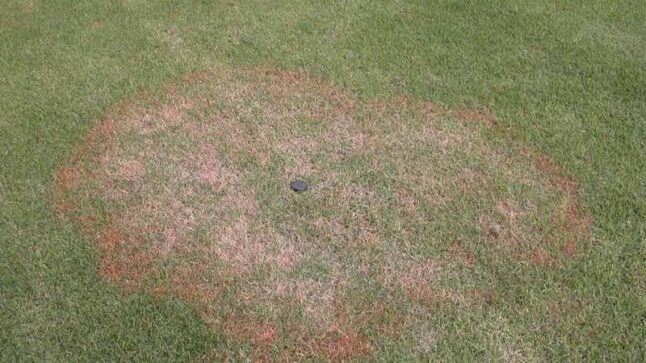
Large patch is Zoysia turfgrass’s most significant fungal disease. It is caused by a strain of the Rhizoctonia stoloni bacteria that only attacks warm-season grasses. Large patch disease thins the grass, making room for weeds, but it typically doesn’t kill the turf. Here’s what to look for to identify it correctly.
Favorable weather: Cool weather (50° to 70°F) during spring and fall, when rains are frequent. Occasionally, it can develop in mid-summer in cooler, shaded areas.
Leaf damage: Leaves turn a yellow-orange tint due to rotting crowns that can no longer sustain nutrition and hydration.
Root damage: Rot and pinpoint, reddish-brown to black lesions develop under the thatch layer on basal leaves and crown. Stolons and roots are not killed and can develop new shoots.
How to identify large patch disease in your lawn: Small, irregular areas up to 12 inches wide with tan-orange grass. They might grow into large, well-defined patches of thin, wilted, off-color grass with an orange exterior ring.
Other symptoms of large patch: In early spring, large thatch infections appear as light brown, sunken areas that are slower to return from dormancy.
Susceptible turfgrasses: Zoysiagrass, Centipedegrass, St. Augustine, Bermudagrass.
Lawn conditions favoring the large patch disease:
- Compact soil with poor drainage.
- Thick thatch layer.
- Excessive nitrogen application in the spring.
- Wet leaves due to evening watering, rain, or heavy dew.
How to get rid of large patch:
- Improve drainage in your lawn.
- Core aerate and dethatch the lawn during summer.
- Apply slow-release nitrogen after the large patch infection stops its activity.
- Avoid mowing wet turf.
- Contact a local lawn care service and make a preventive application with fungicide in late September or early October.
5. Yellow Patch (Cold-season brown patch)
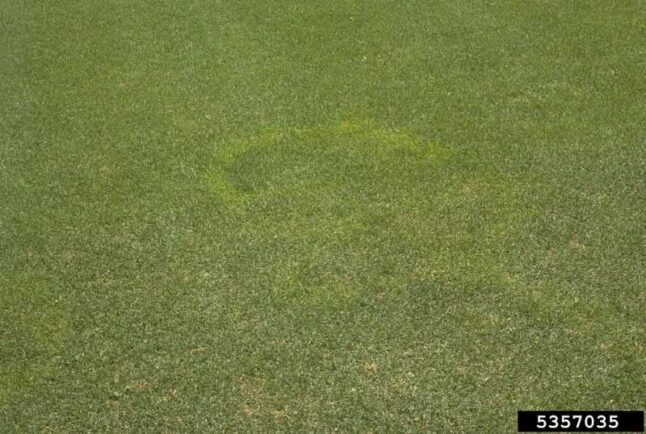
Sometimes referred to as cold-season brown patch, yellow patch is caused by the bacterium Rhizoctonia cerealis, related to Rhizoctonia stoloni. Yellow patch outbreaks occur from fall to spring, and the damage is usually superficial but can lead to thinned areas in your lawn. Here’s how you recognize the disease.
Favorable weather: A cool weather disease, active in mid-spring and mid-fall while temperatures range from 50 to 65°F. Overcast and rainy conditions favor it.
Leaf damage: Yellow to tan chlorosis develops from the tip of the grass blade downwards. Kentucky bluegrass blades can turn a reddish purple.
Root damage: No damage to the roots.
How to identify yellow patch disease in your lawn: Circular yellow to light-brown patches or rings from 5 inches to a few feet wide appear on your lawn.
Other symptoms of yellow patch: Infected turf patches may be tan, orange, or light brown, depending on the grass type.
Susceptible turfgrasses: Creeping bentgrass, Kentucky bluegrass, perennial ryegrass, Bermudagrass, and Zoysiagrass.
Lawn conditions favoring the disease:
- Compacted soil.
- Thick thatch.
- High nitrogen levels.
- Evening irrigation.
- Lawn scalping.
- Low sunlight exposure.
How to get rid of yellow patch:
- Avoid excessive nitrogen applications.
- Improve soil drainage.
- Manually remove dew to reduce leaf wetness.
- Trim trees and shrubs to get more sun in and improve airflow.
- Mechanically remove thatch.
6. Pythium Blight (Grease Spot)
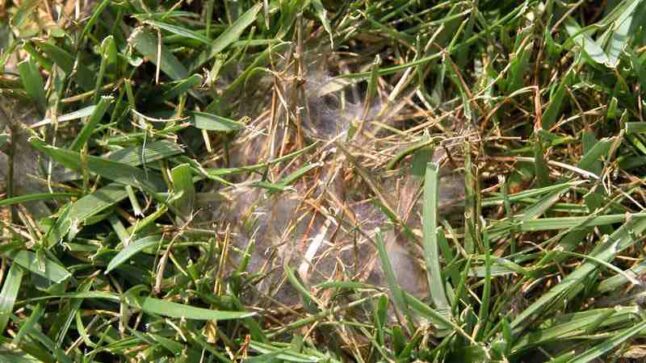
Pythium blight is a disease caused by fungi called Pythium spp., thriving in hot and wet conditions. This disease damages leaves and crowns, acts fast, and kills turf plants, causing severe damage to residential lawns and athletic fields.
Favorable weather: Hot summer periods with 80-95°F during daytime and above 68°F at night. Prolonged dew and afternoon summer rain trigger and spread infection faster.
Leaf damage: Infected grass leaves lie flat and stick together, appearing greasy.
Root damage: In some cases, the grass roots turn brown.
How to identify Pythium blight in your lawn: Small circles of withering, blackened, or reddish-brown grass 2 to 6 inches wide following water patterns in your lawn.
Other symptoms of Pythium blight: Early morning, you’ll see cottony white fungal mycelium masses on the soil and grass.
Susceptible turfgrasses: Perennial ryegrass, creeping bentgrass, fine fescues, and bluegrasses.
Lawn conditions favoring Pythium blight:
- It frequently occurs in wet low spots or overwatered lawns.
- Trees and shrubs shade the lawn.
- Soil compaction.
- A thick thatch layer.
- Excess nitrogen.
How to get rid of Pythium blight:
- Trim trees and shrubs that shade the grass.
- Improve soil aeration and water drainage.
- Correct low spots to prevent waterlogged root zones.
- Manually remove dew.
- Postpone mowing until the grass is dry.
- Don’t apply high levels of nitrogen during hot, humid weather.
7. Fairy Ring
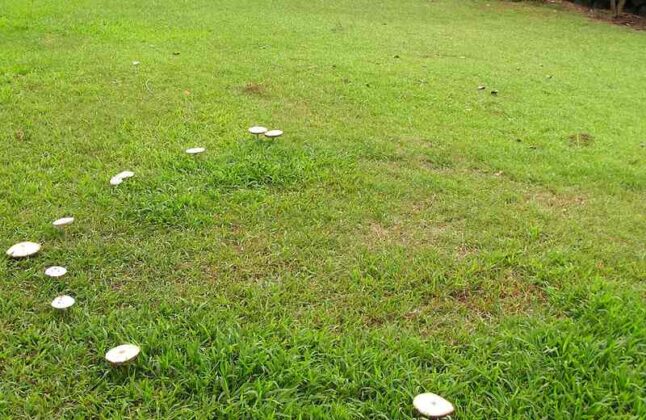
Agrocybe spp., Marasmius oreades, Lepiota spp., and Basidiomycete spp. can cause fairy rings in your lawn. The fungi don’t directly attack the grass. Turf wilts and dies when a high fungal density prevents water from moving through the soil. The grass plants essentially dry out.
Fairy ring fungal pathogens decompose organic matter into nitrogen, making grass in affected areas often grow greener and taller than turf in clean zones.
Favorable weather: It’s active from spring through fall and thrives in hot, dry weather.
Leaf damage: There’s no specific leaf damage. Grass dries out due to water stress.
Root damage: No root damage.
How to identify fairy rings in your lawn: Circles or semicircles up to 20 feet wide consisting of a band of:
- Taller, greener grass
- Dry, straw-colored to light brown turf
- Mushrooms
Learn more about the disease and the three types of fairy rings.
Other symptoms of fairy ring disease: White fungal strands visible in the soil.
Susceptible turfgrasses: All lawn grasses.
Lawn conditions favoring the disease:
- Old tree stumps, logs, lumber, tree roots, and other larger organic material hidden in the soil below the lawn.
- Thick thatch layers.
How to treat fairy ring disease:
- Find and remove all tree stumps, roots, wooden pieces, branches, etc., buried in the ground.
- Clean the lawn of dry leaves, twigs, thatch, and other organic debris.
8. Gray Leaf Spot
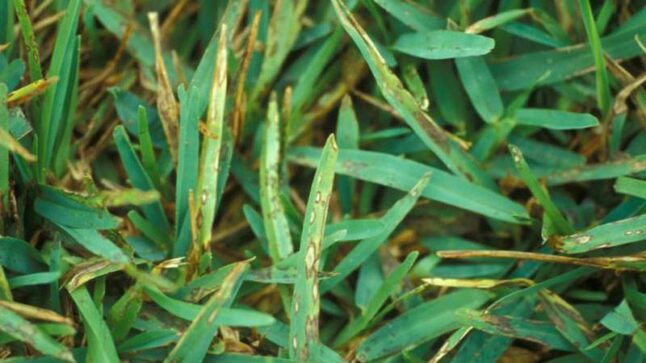
Caused by the fungi Pyricularia grisea and Pyricularia oryzae, the gray leaf spot disease mainly impacts cool-season grasses, but warm-session species are also affected. Perennial ryegrass is most rapidly and severely affected, tall fescue is moderately resistant, and St. Augustine shows the least damage.
Favorable weather: Humid, hot weather (70 to 95°F). It’s a threat for susceptible grasses from summer to mid-fall, but in some cases, it can continue until the first frost.
Leaf damage: Small, water-soaked lesions, gray to light brown with a dark brown border (or a yellow halo for older lesions), later become necrotic. In some plants, lesions merge, and entire blades become bleached and twisted in a fish-hook shape.
Root damage: No root damage.
Other symptoms of gray leaf spot: Bleached, twisted leaves are sometimes covered in grayish spores called conidia.
How to identify gray leaf spot in your lawn: Irregular blighted patches in perennial rye and tall fescue. In St. Augustine lawns, there’s mostly a brown cast with less defined areas.
Susceptible turfgrasses: St. Augustinegrass, perennial ryegrass, centipede, tall fescue, Bermudagrass.
Lawn conditions favoring the disease:
- Newly established lawns
- Shaded turf
- Higher-cut grass
- High nitrogen levels
- Soil compaction
- Water stress
- Herbicides
How to treat gray leaf spot disease:
- Reduce lawn shading.
- Aerate and dethatch periodically.
- Reduce periods of leaf wetness by watering in the early morning.
- Water deeply and infrequently, avoiding moisture stress.
- Apply slow-release nitrogen at reduced rates during summer (0.5 lb N/1,000 sq ft).
- With previous infections, apply preventive fungicides in mid-July.
- Replace ryegrass and tall fescue with less susceptible species (i.e. bentgrass and bluegrass).
9. Fusarium Blight
Fusarium blight is a fungal disease inflicted by the Fusarium culmorum and Fusarium tricinctum pathogens that attack mainly cool-season grasses weakened by drought and high heat.
Favorable weather: Hot (85 to 95°F during the day and over 70°F at night), dry weather.
Leaf damage: Damaged grass blades look bleached, and dead stems have a hard basal area with reddish rot.
Root damage: Crown and root rot.
How to identify Fusarium blight in your lawn: Grayish-green areas with a circular shape, a few inches to a few feet wide. In some cases, the grass regrows in the center, giving it a donut or “frog eye” shape.
Other symptoms of the Fusarium blight disease: A pink layer of fungus sometimes appears on the soil.
Susceptible turfgrasses: Kentucky bluegrass, red fescue, tall fescue, perennial ryegrass, and centipedegrass.
Lawn conditions favoring the disease:
- Drought-stressed lawns.
- Turf with southern exposure and areas near walkways and driveways.
- Grass cut too short.
- Clay compacted soil with poor water circulation.
- Excess nitrogen.
How to get rid of Fusarium blight:
- Irrigate thoroughly to help grass deal with heat and sun.
- Avoid overfertilization during summer.
- Aerate and dethatch the lawn periodically to improve water absorption.
- Mow the lawn higher during high heat.
10. Powdery Mildew
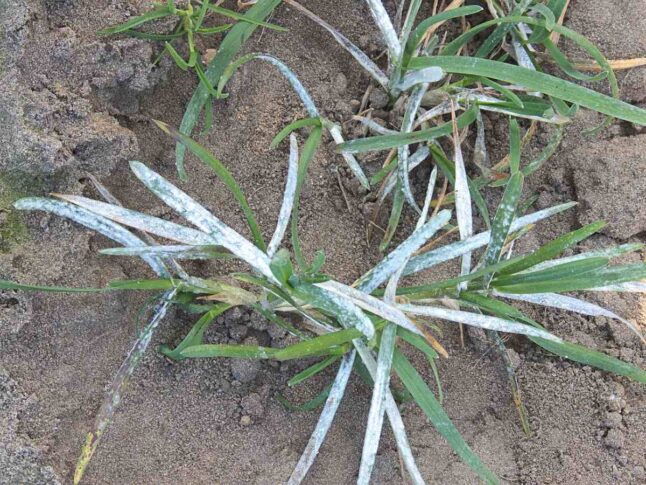
Caused by the fungus Erysiphe graminis, powdery mildew spreads by spores, which give it a white, powdery appearance. Spores travel by air, and infection starts within 2 hours of contact with healthy grass blades. Fungicides are effective preventive measures but can’t help the grass that is already sick.
Favorable weather: A spring and fall disease favored by mild temperatures (60 to 70°F) and high humidity in the air and soil.
Leaf damage: Starts as isolated wefts of fine, gray-white, cobweb-like fungal growth on the tip of the grass blades. As the infection progresses, covering the entire leaf, the grass looks spread with flour or chalk.
Root damage: No root damage.
How to identify powdery mildew in your lawn: Light green whitish areas that look like they’ve been powdered with chalk. Large areas with light green or pale white, withered grass.
Susceptible turfgrasses: Kentucky bluegrass and fescues are the most vulnerable.
Lawn conditions favoring the disease:
- Reduced air circulation
- Low light intensity
- Leaf wetness due to irrigation, heavy dew, rain, or fog.
How to get rid of powdery mildew:
- Trim the trees and shrubs shading the lawn to get more light and air.
- Aerate and dethatch the lawn to prevent water stagnation.
- Adjust watering your lawn according to sun exposure to avoid moisture in shaded areas.
Learn more about controlling this lawn disease in our article How to Treat Powdery Mildew On Your Lawn.
11. Spring Dead Spot
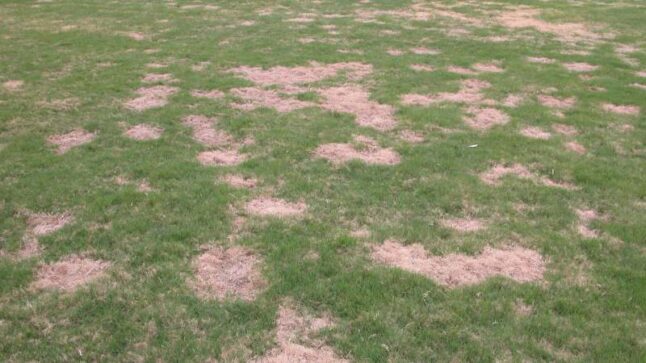
Ophiosphaerella korrae, the fungus causing the spring dead spot disease, attacks dormant warm-season grasses during fall and winter, damaging roots and rhizomes. The results are visible in the spring with new growth. It’s one of the most severe diseases of Bermudagrass lawns. Affected grass eventually dies.
Favorable weather: The disease activates during autumn when temperatures go below 70°F and continues in winter until soil temperatures fall under 50°F.
Leaf damage: No specific leaf damage. Blades wither, dry out, and die due to root damage.
Root damage: Stolons, rhizomes, and roots are rotten and dark in color.
How to identify spring dead spot in your lawn: Circular spots of bleached-out dead grass, 6 to 12 inches wide, can merge into larger patches. Sometimes, the center recovers, creating the appearance of a ring.
Susceptible turfgrasses: Bermudagrass, seashore paspalum, and Zoysiagrass lawns. It typically affects turf that is more than 2 years old.
Lawn conditions favoring the disease:
- Excessive nitrogen applications.
- Potassium deficiencies.
- Poor soil drainage due to compaction and thick thatch.
- Overwatering.
- Alkaline soil.
How to get rid of spring dead spot:
- Remove dead grass from affected patches and aerate the areas three times a year during the growing season.
- Keep away thatch from your lawn.
- Fertilize with nitrogen and potassium during active growth.
- Don’t fertilize in the last 6 weeks before entering winter dormancy.
- Avoid spreading herbicides during recovery.
- Keep soil PH slightly acidic.
12. Summer Patch (Poa Patch)
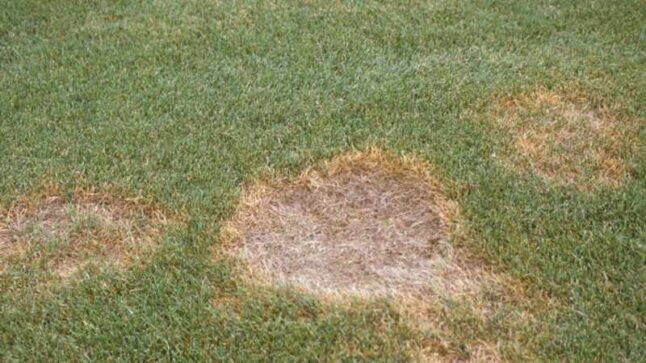
One of the most important turf diseases in North America, summer patch disease, is caused by the Magnaporthe poae pathogen. It damages the roots, making recovery difficult.
Favorable weather: Root infection begins in the spring when soil temperatures range between 65 and 70°F. Foliar symptoms appear early or mid-summer when air temperatures reach over 85°F.
Leaf damage: No specific damage.
Root damage: Turf crowns, stolons, and roots start to rot and have dark fungal growth.
How to identify summer patch in your lawn: Yellow to tan circular areas of dead grass, up to 1 foot wide. Sometimes, there’s green grass in the center that appears healthy, giving patches the frog-eye or donut look.
Other symptoms of summer patch disease: Dense dark brown to black networks of mycelium strands on infected plants.
Susceptible turfgrasses: Kentucky bluegrass, fescues, bentgrass, and annual bluegrass.
Lawn conditions favoring the disease:
- Poor drainage due to soil compaction and thatch.
- Excess nitrogen during spring.
- Alkaline soil.
- Close mowing.
How to get rid of summer patch:
- Aerate and dethatch to improve soil drainage.
- Control the thatch layer.
- Apply 75% of the nitrogen in the fall to avoid excess during spring and summer.
- Reduce soil pH to 5.5–6.
- Raise the mowing height.
13. Leaf Rust
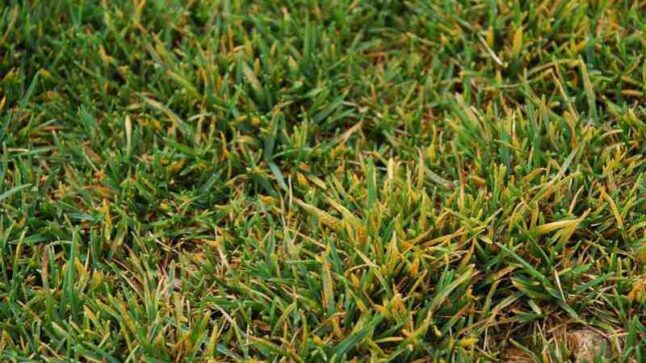
Caused by the Puccinia fungus species, leaf rust is typically a late summer and early fall disease. It doesn’t kill the grass but weakens it enough to make it vulnerable to weeds and pests.
Favorable weather: The pathogen thrives in mild temperatures of 60 to 75°F, overcast and rainy periods.
Leaf damage: Pale yellow spots form on stems and grass blades, aligned parallel with the leaf veins. When larger, the spots rupture and turn into reddish-brown spore masses, taking on a rusty iron look.
Root damage: Doesn’t attack the root.
How to identify leaf rust in your lawn: Golden yellow and then orange-rust irregular patches across the lawn. Orange powder collects on shoes when walking through the grass.
Susceptible turfgrasses: Kentucky bluegrass, perennial ryegrass.
Lawn conditions favoring the disease:
- Prolonged leaf wetness
- Drought-stressed grass
- Nitrogen deficiency
- Soil compaction
- Low exposure to sunlight
How to get rid of leaf rust:
- Follow lawn care recommendations for your turf type (mowing height, fertilization rate, watering schedule) to keep the grass vigorous.
- Remove grass clippings from the lawn if infected.
- Trim trees and shrubs to let more sunlight on a shaded lawn.
14. Leaf Spot
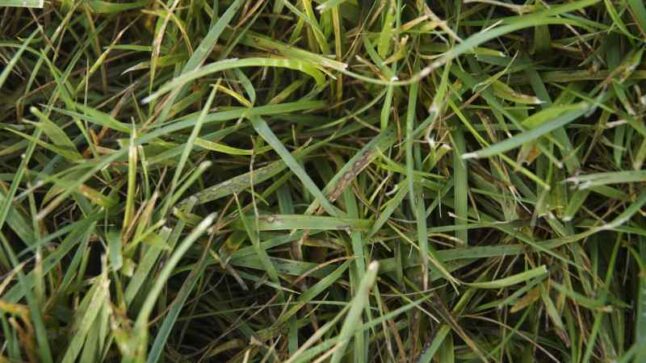
A product of the fungus Bipolaris sorokiniana, leaf spot damages mainly winter grasses during their stress and dormancy period. It attacks all parts of the plant and causes severe damage in residential lawns, athletic fields, and golf courses.
Favorable weather: Active on cool-season grasses during hot summer days with temperatures between 70° and 90°F, long dew periods, and rain.
Leaf damage: Grass stems, sheaths, and blades have elongated or circular light brown spots with dark brown or purple edges.
Root damage: Turf roots and crowns develop brown rot.
How to identify leaf spot in your lawn: Irregular areas with off-color turf. After a windy, hot summer, the turf will show thinned patches with dead grass.
Other symptoms of leaf spot disease: There is no white or gray mycelium on soil or grass. Pathogens are spread by spores.
Susceptible turfgrasses: Kentucky bluegrass, perennial ryegrass, and tall fescue.
Lawn conditions favoring the disease:
- Close mowing.
- Overwatering.
- Poor drainage due to soil compaction and thatch.
- High nitrogen fertility.
- Shade and poor air circulation due to dense trees and shrubs.
Hot to get rid of leaf spot disease:
- Dethatch and aerate the lawn to improve air circulation and drainage.
- Mow the turf at the highest level recommended for the grass type.
- Trim trees and shrubs to reduce shade.
- Water early in the morning.
- Avoid over-fertilizing with nitrogen in the spring.
Learn more about this disease and how to treat it in our article on how to control leaf spot in the lawn.
15. Melting Out
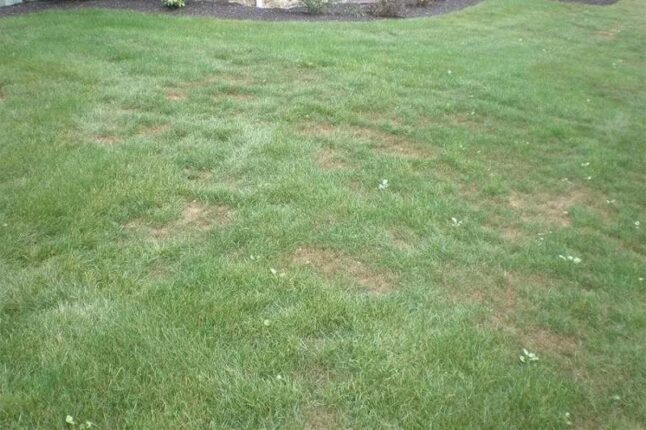
Similar in symptoms to leaf spot, melting out is a cool-weather fungal disease caused by the pathogen Drechslera poae. It’s a windborne disease, easily spread across the lawn.
Favorable weather: Attacks in the spring and early summer when temperatures range between 50 and 75°F.
Leaf damage: Circular to elongated straw-colored spots with brown or purple edges on grass leaves, sheaths, and stems.
Root damage: A dark brown rot affects the root system and plant crown.
How to identify melting out in your lawn: Patches of yellow to blackish-brown wilted or dead grass.
Susceptible turfgrasses: Kentucky bluegrass, perennial ryegrass, and tall fescue.
Lawn conditions favoring the disease:
- Overfertilized turf.
- Shaded areas with poor air circulation.
- Lawns mowed too short.
- Thick thatch layer.
- Poor drainage.
How to treat melting out:
- Limit shaded areas in your lawn.
- Keep the lawn mower blades high.
- Avoid spreading too much nitrogen on your turf.
- Aerate and dethatch to improve drainage and prevent water pooling.
Get more detailed control tips in our article on how to get rid of melting out in turfgrass.
16. Take-All Root Rot (TARR)
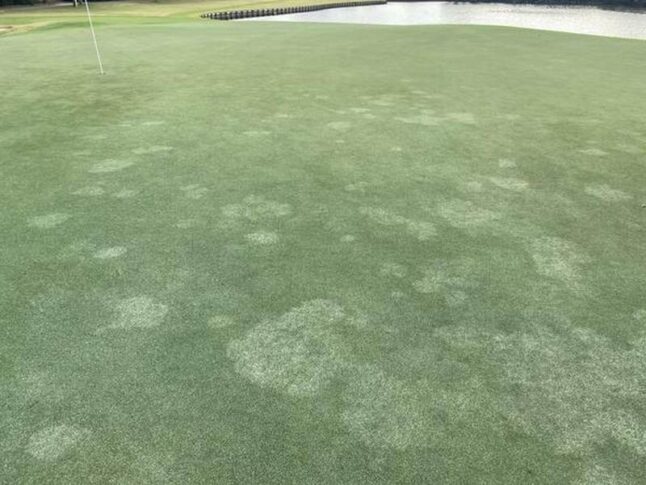
Caused by the Gaeumannomyces graminis fungus, take-all root rot (TARR) is a severe turf disease that goes for turf roots. It does not attack the grass leaves. What you see on your lawn at blade level is the result of rotten roots and shows that the pathogen has already been in the soil for 2 to 3 weeks.
Favorable weather: Appears in late spring and early summer when grass exits dormancy and stays active during the growth season.
Leaf damage: No specific damage.
Root damage: Roots are initially off-white and thin with black lesions. Later, they become dark, short, and rotted.
How to identify TARR in your lawn: Chlorotic, yellow to light green patches from a few inches to a few feet wide. The grass eventually turns brown, thins out, and affected patches become bare areas.
Other symptoms of take-all root rot disease: Stolons and rhizomes have dark lesions and can begin to rot.
Susceptible turfgrasses: Bermudagrass (TARR is also known as Bermudagrass decline), St. Augustine, all warm-season turfgrasses.
Lawn conditions favoring take-all root rot:
- Heat and drought stress.
- Low exposure to sunlight.
- Alkaline soil.
- Soil compaction.
- Herbicide injury.
- Water high in sodium.
How to get rid of take-all root rot:
- Mow at the correct height during summer, cutting a maximum of ⅓ of the height at a time.
- Fertilize with equal amounts of nitrogen and potassium to protect the roots.
- Aerate and dethatch the lawn to improve drainage.
- Lower soil pH.
- Contact a local lawn care professional to help you with the correct fungicidal treatment.
17. Leaf Blight
This disease is caused by fungi from the Ascochyta species that spread their spores during wet weather, infecting freshly mowed grass tips. Fortunately, the damage is not permanent, and the grass recovers quickly since the disease doesn’t affect roots and crowns.
Favorable weather: Leaf blight is active in late spring and early summer when the weather shifts from wet and cool to dry and hot.
Leaf damage: Some grass blades have a bleached tip, and others have uniform lesions on the entire surface. Often the lower blades and grass crown remain healthy.
Root damage: None.
How to identify leaf blight in your lawn: Irregular patches with blighted straw-colored or brown grass appear overnight.
Susceptible turfgrasses: Annual bluegrass, creeping bentgrass, perennial ryegrass, tall fescue, Kentucky bluegrass, and fine fescues.
Lawn conditions favoring the disease:
- Drought- or heat-stressed turf following a rainy period or overwatering.
- Poor drainage due to soil compaction and thick thatch.
- Low soil fertility.
- Overwatering and poor irrigation uniformity.
How to get rid of leaf blight:
- Dethatch at least once a year.
- If you see signs of disease, mow less frequently and let the grass grow taller.
- Don’t mow when the grass is wet.
- Avoid nitrogen excess during spring.
18. Gray Snow Mold (Typhula blight)
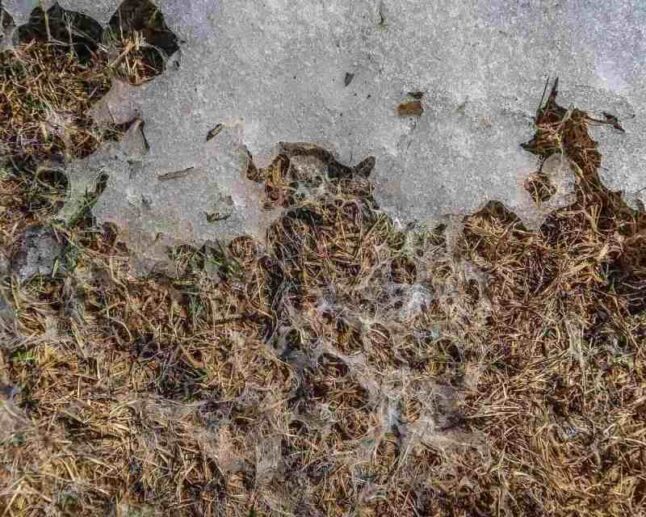
Snow mold is caused by Typhula incarnata, a cold-loving fungus that uses the wet and dark medium created under snow cover to attack grass plants. The fungi remain dormant in leaf litter and thatch from spring to the next winter snow.
Favorable weather: Mid to late winter when snow blankets cover the lawn. Symptoms are visible in the spring. The disease is most severe when snow covers unfrozen ground.
Leaf damage: Tiny, reddish-brown, pea-like fungal growths are present on the leaves and crowns of infected grass plants.
Root damage: It kills grass blades but rarely damages roots.
How to identify gray snow mold in your lawn: Whitish or straw-like crusted circular or irregular patches of dead grass, with matted leaf blades, ranging from a few inches to 3 feet in size.
Other symptoms of gray snow mold: You might spot gray fungal mycelium near receding snow banks.
Susceptible turfgrasses: All cool-season turfgrasses. Annual bluegrass, creeping bentgrass, perennial ryegrass, and tall fescue are more easily damaged. Fine fescues and Kentucky bluegrass are more resilient.
Lawn conditions favoring the disease:
- Excessive nitrogen fertilization
- Infrequent mowing and high mowing heights going into winter
- Dead leaves left on the lawn
How to get rid of gray snow mold:
- Mow your lawn to the proper height until late fall.
- Avoid fertilizing close to the cold season.
- Don’t store snow from walkways and driveways on the lawn.
- Clean twigs, dry leaves, and all debris from the lawn.
- Use snow fences or plants to reduce snow cover.
- Avoid walking on a snowed-in lawn.
Learn more in our article all about how to get rid of snow mold.
19. Pink Snow Mold (Microdochium patch)
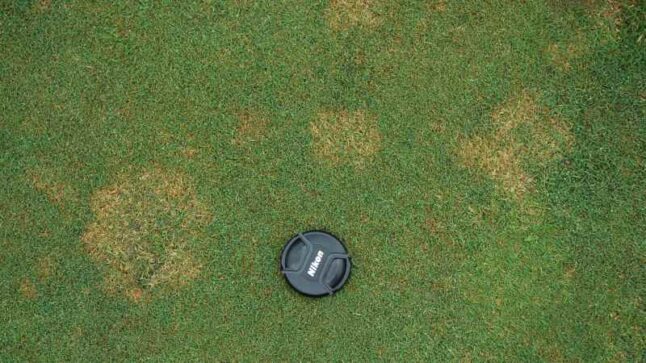
Caused by the Microdochium nivale fungus, pink snow mold attacks all parts of the grass plants. It thrives in the moisture and warmth caught under the snow layer during winter. Infestation signs are visible during spring. In some cases, you need to reseed the affected areas.
Favorable weather: It develops during the winter in wet periods with temps of 40° to 60°F and thick snow cover. A damp fall makes it more severe.
Leaf damage: First, grass blades look water-soaked. Then they turn reddish brown and finally look bleached with pink coloration.
Root damage: Roots and crowns are affected.
How to identify pink snow mold in your lawn: Pink, white, or tan circular patches 1 to 2 inches wide extending up to 1 foot appear when the snow melts in the spring.
Other symptoms of pink snow mold: Affected grass is often covered in white to pink fungal growth.
Susceptible turfgrasses: All cool-season grasses. Annual bluegrass, creeping bentgrass, and perennial ryegrass are the most severely damaged.
Lawns conditions favoring the disease:
- Lawns over-fertilized with nitrogen during fall.
- Neutral or alkaline soil pH.
- Grass mowed too tall or neglected in the fall.
- Organic debris left on the lawn (dead leaves, mulch, twigs, etc.)
How to get rid of pink snow mold:
- Make the last mow before winter shorter.
- Avoid overfertilizing in the autumn.
- Don’t throw snow gathered from the driveway on the lawn.
- Rake dry leaves, dead grass, mulch, and all organic debris from the lawn before the first snow.
- Apply preventive fungicide in the fall.
Our article on how to get rid of snow mold can also help with this variety of the disease.
20. Anthracnose Foliar Blight and Root Rot
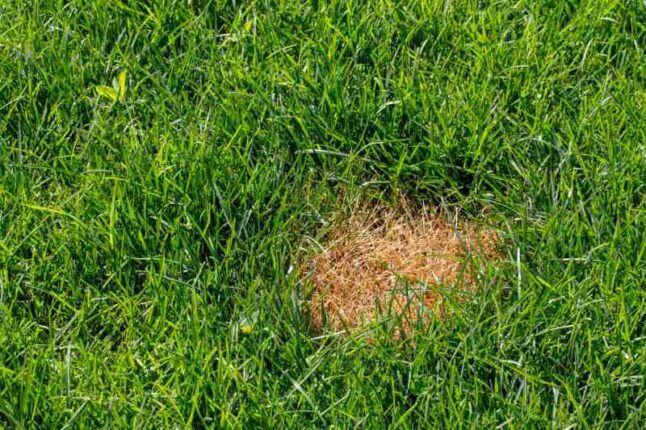
Caused by the fungus Colletotrichum cereale, anthracnose can behave as a foliar blight and as a root, stolons, and crown rot disease. When it attacks the crown and root, it’s more virulent and damaging, often killing the grass.
Favorable weather: During the entire growing season on bluegrass turf, summer and late fall in bentgrass.
Leaf damage: Reddish-tan leaf lesions (creeping bentgrass) or elongated, chlorotic spots with small, black structures in the middle (annual bluegrass). Damage always starts from the lowest, oldest leaves and moves up, while individual blades die from their tip down.
Root damage: Dark brown to black lesions on basal roots. In this case, leaf blades don’t show lesions and turn an orange to yellow tint. Grass sheaths and stolons can also be affected.
How to identify anthracnose in your lawn: Bright yellow, reddish, or bronze patches of various sizes, from small freckle-like spots to circular patches up to 1 foot wide. Turf thinning.
Other signs of anthracnose disease: Black hairline spore structures are present on infected leaves and stems, best noticed with a magnifying glass.
Susceptible turfgrasses: Annual bluegrass, creeping bentgrass, Kentucky bluegrass, fine-leaf fescues, perennial ryegrass, and Bermudagrass.
Lawn conditions favoring the disease:
- Low fertility.
- Heavy traffic.
- Heat and drought stress.
- Poor soil drainage due to compaction and excessive thatch.
- Low mowing heights.
- Excess water in soil and leaf canopy.
How to get rid of anthracnose:
- Fertilize with complete fertilizers (nitrogen, potassium, and phosphorous).
- Water deeply and infrequently.
- Mow the grass taller and less often.
- Improve drainage through soil aeration and dethatching in spring and fall.
- Trim trees to reduce shade.
- Remove heavy dew manually.
Our article How to Get Rid of Anthracnose in Your Lawn provides more in-depth information about treatments and prevention.
How to Prevent Lawn Diseases
The best way to prevent fungal diseases is to keep your lawn healthy and vigorous by using a correct lawn care routine, including:
Choose the right grass for lawn conditions:
- Avoid planting sun-loving turfs in shaded areas or cool-season grasses in warm climates on lawns with southern exposure.
- Plant salt-tolerant turf types in lawns exposed to salt spray or brackish water irrigation.
- Choose drought-tolerant grasses for lawns in dry climates and sloped lawns.
- Go for grasses that can deal with high moisture in a yard that floods occasionally.
Mow at the right height and frequency:
- Keep the recommended mowing heights for your turf and adapt them to each season.
- Only cut a maximum of ⅓ of the blade’s height every time you mow.
- Don’t mow wet grass.
- Keep on mowing until growth stops. Lawn care professionals can help you if you lack the time for routine maintenance.
Ensure fertile soil with good water drainage:
- Aerate and dethatch the lawn annually.
- Install additional drainage systems if necessary (french drains, collecting ponds, etc).
- Amend with compost rich in organic matter to improve soil texture.
- Consider leveling and reinstalling the lawn if problems persist.
- Test the soil before installing the lawn and once every two years.
- Fertilize correctly for the type of grass, growth stage, weather, and soil condition.
Keep moisture under control:
- Water deeply and less often to support deep roots and limit surface moisture.
- Avoid evening irrigation.
- Adapt to turfgrass water requirements and seasonal changes.
- Manually remove dew to avoid prolonged leaf wetness.
Manage air circulation:
- Trim trees and shrubs to improve airflow and sunlight exposure.
- Remove dry leaves, fallen branches, and twigs from the lawn.
- Collect grass clippings after mowing the lawn during rainy periods.
FAQ About Lawn Diseases
No, slime mold is not a fungal lawn disease but amoeba-like organisms that feed on bacteria and migrate on grass blades during humid, warm periods. They form white, yellow, orange, blue, or gray patches in turf, looking like fungal spores. Slime molds don’t damage the grass or its roots. Still, they can shade the turf if covering large areas for a prolonged time, limiting photosynthesis.
To identify turf diseases:
• Observe the soil fertility, drainage abilities, and weather conditions
• Check symptoms on grass blades, stems, crowns, roots, and stolons
• Compare them with the most common fungal diseases for your type of turf
Fungicides are most effective when used preventively, and the best treatment is a proper lawn care maintenance routine to promote deep roots and healthy grass. If you want to try chemical control, here are the best lawn fungicides we recommend.
When to Call a Lawn Care Professional
Call a lawn care professional when:
- You see the first signs of a fungal disease. With the correct treatment, your lawn will recover faster and easier.
- The disease keeps coming back yearly despite your preventive actions and treatments.
- Preventive fungal applications are necessary.
- You’re not sure what’s wrong with your lawn.
LawnStarter can connect you with excellent lawn care specialists all around the country. Contact a local lawn care company today and return your lawn to its beautiful, green, healthy look.
Main Photo Credit: photo_Pawel / Canva Pro / License

